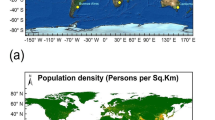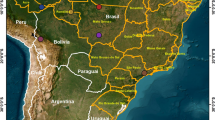Abstract
Climate change is predicted to induce more extreme events such as storms, heat waves, drought and floods. Dust storms are frequently occurring in northern China. Those storms degrade air quality by decreasing visibility and inducing cardiovascular and respiratory diseases. To control dust storms, the Chinese government has launched a large-scale afforestation program by planting trees in arid areas, but the effectiveness of this program is still uncertain because the trajectories and altitudes of dust transport are poorly known. In particular, afforestation would be effective only if dust transport occurs at low altitudes. To test this hypothesis, we analyzed the extreme dust storm from May 2 to 7, 2017, which resulted in record-breaking dust loads over northern China. For that, we used dust RGB-composite data from the Himawari-8 satellite and the cloud-aerosol lidar, moderate-resolution imaging spectroradiometer data, and surface monitoring data. The source regions of the dust storms were identified using the hybrid single-particle Lagrangian integrated trajectory model and infrared pathfinder satellite observation. Contrary to our hypothesis, results show that dust is transported at high altitude of 1.0–6.5 km over long distances from northwestern China. This finding explains why the afforestation has not been effective to prevent this storm. Results also disclose the highest particulate matter (PM) concentrations of 447.3 μg/m3 for PM2.5 and 1842.0 μg/m3 for PM10 during the dust storm. Those levels highly exceed Chinese ambient air quality standards of 75 μg/m3 for PM2.5 and 150 μg/m3 for PM10.




Similar content being viewed by others
References
Beniston M, Stephenson DB, Christensen OB, Ferro CAT, Frei C, Goyette S, Halsnaes K, Holt T, Jylhä K, Koffi B, Palutikof J, Schöll R, Semmler T, Woth K (2007) Future extreme events in European climate: an exploration of regional climate model projections. Clim Change 81(Suppl 1):71. https://doi.org/10.1007/s10584-006-9226-z
Bi J, Huang J, Holben B, Zhang G (2016) Comparison of key absorption and optical properties between pure and transported anthropogenic dust over East and Central Asia. Atmos Chem Phys 16:1–37. https://doi.org/10.5194/acp-16-15501-2016
Bishop JK, Davis RE, Sherman JT (2002) Robotic observations of dust storm enhancement of carbon biomass in the North Pacific. Science 298:817–821. https://doi.org/10.1126/science.1074961
Cao JJ, Chow JC, Watson JG, Wu F, Han YM, Jin ZD, Shen ZX, An ZS (2008) Size-differentiated source profiles for fugitive dust in the Chinese Loess Plateau. Atmos Environ 42:2261–2275. https://doi.org/10.1016/j.atmosenv.2007.12.041
Crooks JL, Cascio WE, Percy MS, Reyes J, Neas LM, Hilborn ED (2016) The association between dust storms and daily non-accidental mortality in the United States, 1993–2005. Environ Health Persp 124:1735–1743. https://doi.org/10.1289/EHP216
Dubovik O, Holben B, Eck TF, Smirnov A, Kaufman YJ, King MD, Tanré D, Slutsker I (2002) Variability of absorption and optical properties of key aerosol types observed in worldwide locations. J Atmos Sci 59:590–608. https://doi.org/10.1175/1520-0469(2002)059%3c0590:VOAAOP%3e2.0.CO;2
Eck TF, Holben BN, Reid JS, Dubovik O, Smirnov A, O’Neill NT, Slutsker I, Kinne S (1999) Wavelength dependence of the optical depth of biomass burning, urban, and desert dust aerosols. J Geophys Res Atmos 104:31333–31349. https://doi.org/10.1029/1999JD900923
Evan AT, Heidinger AK, Bennartz R, Bennington V, Mahowald NM, Corrada-Bravo H, Velden CS, Myhre G, Kossin JP (2008) Ocean temperature forcing by aerosols across the Atlantic tropical cyclone development region. Geochem Geophys Geosyst 9:Q05V04. https://doi.org/10.1029/2007GC001774
Holben BN, Eck TF, Slutsker I, Tanré D, Buis JP, Setzer A, Vermote E, Reagan JA, Kaufman YJ, Nakajima T, Lavenu F, Jankowiak I, Smirnov A (1998) AERONET-A federated instrument network and data archive for aerosol characterization. Remote Sens Environ 66:1–16. https://doi.org/10.1016/S0034-4257(98)00031-5
Huang K, Zhuang GS, Li J, Wang QZ, Sun Y, Lin YF, Fu JS (2010) Mixing Asian dust with pollution aerosol and the transformation of aerosol components during the dust storm over China in spring 2007. J Geophys Res Atmos 115:1307–1314. https://doi.org/10.1029/2009JD013145
Hunt WH, Winker DM, Vaughan MA, Powell KA, Lucker PL, Weimer C (2009) CALIPSO lidar description and performance assessment. J Atmos Ocean Technol 26:1214–1228. https://doi.org/10.1175/2009JTECHA1223.1
Ichinose T, Yoshida S, Hiyoshi K, Sadakane K, Takano H, Nishikawa M, Mori I, Yanagisawa R, Kawazato H, Yasuda A, Shibamoto T (2008) The effects of microbial materials adhered to Asian sand dust on allergic lung inflammation. Arch Environ Contam Toxicol 55:348–357. https://doi.org/10.1007/s00244-007-9128-8
IPCC (2013) Climate change 2013: the physical science basis: contribution of working group I to the fifth assessment report of the intergovernmental panel on climate change. Volume IPCC WGI fifth assessment report. Cambridge University Press, Cambridge
Jacobson MZ (2000) A physically-based treatment of elemental carbon optics: implications for global direct forcing of aerosols. Geophys Res Lett 27:217–220. https://doi.org/10.1029/1999GL010968
Johnston F, Hanigan I, Henderson S, Morgan G, Bowman D (2011) Extreme air pollution events from bushfires and dust storms and their association with mortality in Sydney, Australia 1994–2007. Environ Res 111:811–816. https://doi.org/10.1016/j.envres.2011.05.007
Jung J, Yu JA, Lyu Y, Lee M, Hwang T, Lee S (2017) Ground-based characterization of aerosol spectral optical properties of haze and Asian dust episodes under Asian continental outflow during winter 2014. Atmos Chem Phys 17:5297–5309. https://doi.org/10.5194/acp-2016-961
Kang JH, Liu TC, Keller J, Lin HC (2013) Asian dust storm events are associated with an acute increase in stroke hospitalisation. J Epidemiol Commun H 67:125–131. https://doi.org/10.1136/jech-2011-200794
Kim D, Chin M, Kemp EM, Tao ZN, Peters-Lidard CD (2017) Development of high-resolution dynamic dust source function—a case study with a strong dust storm in a regional model. Atmos Environ 159:11–25. https://doi.org/10.1016/j.atmosenv.2017.03.045
Lensky IM, Rosenfeld D (2008) Clouds-aerosols-precipitation satellite analysis tool (CAPSAT). Atmos Chem Phys 8:6739–6753. https://doi.org/10.5194/acp-8-6739-2008
Liu QY, Liu YJ, Yin JX, Zhang MG, Zhang TT (2014) Chemical characteristics and source apportionment of PM10 during Asian dust storm and non-dust storm days in Beijing. Atmos Environ 91:85–94. https://doi.org/10.1016/j.atmosenv.2014.03.057
Mamouri RE, Ansmann A, Nisantzi A, Solomos S, Kallos G, Hadjimitsis DG (2016) Extreme dust storm over the eastern Mediterranean in September 2015: satellite, lidar, and surface observations in the Cyprus region. Atmos Chem Phys 16:13711–13724. https://doi.org/10.5194/acp-16-13711-2016
Seinfeld JH, Pandis SN (2016) Atmospheric chemistry and physics: from air pollution to climate change, 3rd edn. Wiley, Hoboken, pp 970–972
Shao Y, Dong CH (2006) A review on East Asian dust storm climate, modelling and monitoring. Glob Planet Change 52:1–22. https://doi.org/10.1016/j.gloplacha.2006.02.011
Shen ZX, Cao JJ, Arimoto R, Han ZW, Zhang RJ, Han YM, Liu SX, Okuda T, Nakao S, Tanaka S (2009) Ionic composition of TSP and PM2.5 during dust storms and air pollution episodes at Xi’an. China Atmos Environ 43:2911–2918. https://doi.org/10.1016/j.atmosenv.2009.03.005
Song Z (2004) A numerical simulation of dust storms in China. Environ Model Softw 19:141–151. https://doi.org/10.1016/S1364-8152(03)00116-6
Sun T, Che H, Qi B, Wang Y, Dong Y, Xia X, Wang H, Gui K, Zheng Y, Zhao H, Ma Q, Du R, Zhang X (2018) Aerosol optical characteristics and their vertical distributions under enhanced haze pollution events: effect of the regional transport of different aerosol types over eastern China. Atmos Chem Phys 18:1–45. https://doi.org/10.5194/acp-18-2949-2018
Tan SC, Li JW, Che HZ, Chen B, Wang H (2017) Transport of East Asian dust storms to the marginal seas of China and the southern North Pacific in spring 2010. Atmos Environ 148:316–328. https://doi.org/10.1016/j.atmosenv.2016.10.054
Tong DQ, Dan M, Wang T, Lee P (2012) Long-term dust climatology in the western United States reconstructed from routine aerosol ground monitoring. Atmos Chem Phys 12:5189–5205. https://doi.org/10.5194/acp-12-5189-2012
Wang YQ, Zhang XY, Draxler D (2009) TrajStat: GIS-based software that uses various trajectory statistical analysis methods to identify potential sources from long-term air pollution measurement data. Environ Model Softw 24:938–939. https://doi.org/10.1016/j.envsoft.2009.01.004
Wang S, Yu S, Li P, Wang L, Mehmood K, Liu W, Yan R, Zheng X (2017) A study of characteristics and origins of haze pollution in Zhengzhou, China, based on observations and hybrid receptor models. Aerosol Air Qual Res 17:513–528. https://doi.org/10.4209/aaqr.2016.06.0238
Winker DM, Pelon J, McCormick MP (2003) The CALIPSO mission: spaceborne lidar for observation of aerosols and clouds. Proc SPIE 4893:1211–1229. https://doi.org/10.1117/12.466539
Yu S, Saxena VK, Wenny BN, Deluisi JJ, Yue GK, Petropavlovskikh IV (2000) A study of the aerosol radiative properties needed to compute direct aerosol forcing in the southeastern United States. J Geophys Res Atmos 105:24739–24749. https://doi.org/10.1029/2000JD900346
Yu S, Zhang Q, Yan R, Wang S, Li P, Chen B, Liu W, Zhang X (2014) Origin of air pollution during a weekly heavy haze episode in Hangzhou, China. Environ Chem Lett 12:543–550. https://doi.org/10.1007/s10311-014-0483-1
Zhang XY, Arimoto R, An ZS (1997) Dust emission from Chinese desert sources linked to variations in atmospheric circulation. J Geophys Res 102:28041–28047. https://doi.org/10.1029/97JD02300
Zhang Y, Peng CH, Li WZ, Tian LX, Zhu Q, Chen H, Fang XQ, Zhang GL, Liu GB, Mu XM, Li ZB, Li SQ, Yang YZ, Wang J, Xiao XM (2016) Multiple afforestation programs accelerate the greenness in the ‘Three North’ region of China from 1982 to 2013. Ecol Indic 61:404–412. https://doi.org/10.1016/j.ecolind.2015.09.041
Acknowledgements
This work was partially supported by the Department of Science and Technology of China (Nos. 2016YFC0202702; 2014BAC22B06) and National Natural Science Foundation of China (No. 21577126). This work was also supported by the Joint NSFC–ISF Research Program (No. 41561144004), jointly funded by the National Natural Science Foundation of China and the Israel Science Foundation. Part of this work was also supported by the “Zhejiang 1000 Talent Plan” and Research Center for Air Pollution and Health in Zhejiang University. The views expressed in this presentation are those of the author(s) and do not necessarily represent those of the US EPA.
Author information
Authors and Affiliations
Corresponding authors
Additional information
Publisher's Note
Springer Nature remains neutral with regard to jurisdictional claims in published maps and institutional affiliations.
Rights and permissions
About this article
Cite this article
Guo, P., Yu, S., Wang, L. et al. High-altitude and long-range transport of aerosols causing regional severe haze during extreme dust storms explains why afforestation does not prevent storms. Environ Chem Lett 17, 1333–1340 (2019). https://doi.org/10.1007/s10311-019-00858-0
Received:
Accepted:
Published:
Issue Date:
DOI: https://doi.org/10.1007/s10311-019-00858-0




